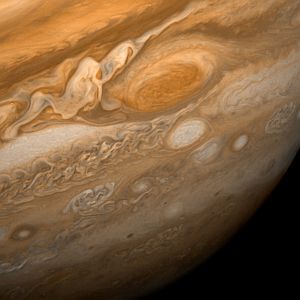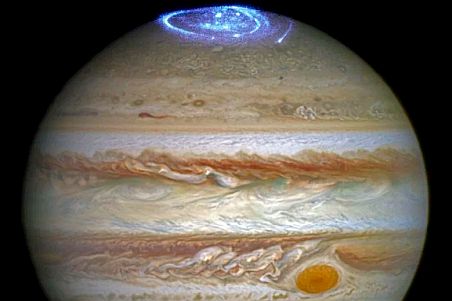
Für eine deutsche Übersetzung dieser Seite einfach die Brandenburger Flagge anklicken
 |
Click the Brandenburg Flag for a German translation Für eine deutsche Übersetzung dieser Seite einfach die Brandenburger Flagge anklicken |


|
|
JupiterA collection of pictures of the planet Jupiter
|
|



|
The gas giant Jupiter is the largest planet in our solar system. Being the third-brightest
object in the night sky (after Moon and Venus), it has
been known since ancient times. It was first observed by telescope in 1610, when Galileo Galilei
pointed his telescope at it and discovered the famous Galilean moons. The first closeup pictures were delivered during the flyby of Pioneer 10 in 1973. Since then, six other probes flew by Jupiter in Gravity assist maneuvers. Two probes, Galileo and Juno have orbited the planet. The Hubble space telescope too delivered some very detailed images. The picture to the left was taken by Hubble on June 27, 2019. Source: NASA/ESA/spacedaily.com |

|
Here is the first set of our favorite orbital pictures of Jupiter. Like our other space galleries, the pictures have not been selected because of their
scientific significance but because of their esthetic value and sometimes because of their historical importance. Systematic observation of Jupiter started as early as 3500 BC in Babylon. To the Babylonians, Jupiter represented their god Marduk. The Babylonians were the first to calculated Jupiter's time to orbit the sun as approximately 12 years and used that orbit to define the constellations of their zodiac. Until this day, East Asian dating and astrological systems follow a 12-year pattern; a circle that is based on the orbit of Jupiter. In 1885, Agnes Mary Clerke published the highly acclaimed book A Popular History of Astronomy during the Nineteenth Century. |
|
On the first page,
the book showed an unaccredited picture of Jupiter, taken through a telescope in 1879. A few years later, California's Lick Observatory took the first clear picture, showing Jupiter's famous Great Red Spot Agnes M. Clerke's book also contained drawings by German astronomer Dr. Otto Boedickker, done in 1888. A more detailed drawing, showing the Great Red Spot, the cloud bands, the four Galilean moons and even the shadow of Moon Io casted on Jupiter's surface was produced by Canadian astronomer G. E. Lumsden in 1891. |
  Unaccredited picture taken of Jupiter through a telescope in 1879 Source: Agnes M. Clerke / Project Gutenberg |
  1891 photograph taken at the Lick Observatory, Mt. Hamilton, California Source: Database of Planetary Images, LESIA / CBS |

  Drawings by Dr. Otto Boedickker, 1888 Source: Agnes M. Clerke / Project Gutenberg / CBS News |
  Drawing by G. E. Lumsden, 1891 Source: ESA / Planetary Society |

|
The first closeup pictures were brought to us by NASA's Pioneer 10 spacecraft. The probe was launched on March 2, 1972. On July 15, 1972, it became the first spacecraft to enter the asteroid belt. On December 3, 1973, Pioneer 10 passed Jupiter at a distance of 82,178 miles (132,252 km). The picture to the right was taken at the closest approach. The probe started taking pictures 17 days before passing the planet. The sequence of pictures below, taken between November 17 and December 1, 1973, does not show a better resolution than pictures taken by telescopes on earth, but nonetheless, these were the first images of Jupiter, taken by a space probe. |
  Jupiter from 82,178 miles, December 3, 1973 Source: NASA / Wikipedia |
  Artist's impression of Pioneer 10's flyby of Jupiter Source: Rick Guidice / Wikipedia |


|
| 17 day sequence of the approach. Source: NASA |

  Jupiter with Io's shadow, December 2, 1973 Source: NASA |
  Sunrise on a crescent Jupiter, December 5; Pioneer 10's last picture, December 31, 1973 Source: NASA |
From Earth, Jupiter always appears as a full disk. Phases, like those of Venus can only be seen if the object is between the observer and the sun. After passing the planet, Pioneer 10 took a series of pictures of a crescent Jupiter. The two center images to the left show the planet on December 5 and Decenber 31. On New Year's Eve, 1973, Pioneer 10 took its last picture of Jupiter from a distance of 9.95 million miles. |

| Pioneer 10 and 11 were the first spacecrafts to achieve the escape velocity needed to leave the solar system. By now, both spacecraft have crossed the Kuiper Belt and are about to enter interstellar space. On January 3, 2019, Pioneer 10 was predicted to be 122.594 astronomical units (AU) from the Earth, travelling at 2.52 AU per year. The Heliopause, the theoretical boundary where the Sun's solar wind is stopped by the interstellar medium is about 181 AU from the sun. |

  Drawing of the Pioneer Plaque Source: Wikipedia |
Both probes carry a gold-anodized aluminum plaque, symbolizing the hyperfine transition of neutral hydrogen,
depicting a man and a woman and their size relative to the space craft, and describing the solar system and its location relative to a number
of pulsars. The plaque, humanities first message to the world outside our solar system was the idea of journalist Eric Burgess, who approached Carl Sagan, who in turn approached NASA. |
  The plaque, mounted onto Pioneer 10 Source: Wikipedia |


|
A year after Pioneer 10, on December 3, 1973, Pioneer 11, on its way to Saturn, was the first probe to
use Jupiter for a gravity assist maneuver. Pioneer 11 passed the planet at a distance of only 27,000 miles and delivered the to date best images of the Great Red Spot and the first pictures of Jupiter's north polar region. In 1979, Voyager 1 and Voyager 2 used the gravity assist and delivered more pictures. Ulysses in 1992, Cassini in 2000 and New Horizons also used Jupiter for a slingshot and tested their cameras during the flyby. |
  Pioneer 11 Great Red Spot prior to closest approach Source: NASA / Wikipedia |
  Pioneer 11 Polar region from 670,000 miles Source: NASA |


 |
 |
 |
|
Great Red Spot from 5.7 million miles Voyager 1, February 25, 1979 Source: NASA / JPL |
Southern hemisphere and moon Io from 8 million miles Voyager 2, June 25, 1979 Source: NASA / JPL |
Infrared image from 1.6 million miles New Horizons, February 27, 2007 Source: NASA / JPL |

|
We conclude our collection of pictures of Jupiter from far away with a caption of powerful aurorae circling the north pole, taken by the Hubble space telescope and by the closest look at the Great Red Spot prior to Juno, taken by Voyager 1.
|

 |

|
|
Aurorae on the North Pole, Hubble, July 1, 2016 Source: ESA / NASA / time.com |
Great Red Spot, Voyager 1, March 5, 1979 Source: NASA / cosmosmagazine.com |


|
So far, two NASA probes have orbited the giant planet. Galileo orbited Jupiter for almost eight years from December 8, 1995 to September 21, 2003. Juno entered Jupiter's orbit on July 5, 2016 and will stay in orbit at least until 2021. |
 |

|


|
|
Click here to return to comet Churyumov–Gerasimenko | Click here to move on to Jupiter's orbit |
|

|
Back to Solar System Page |
Back to Space Page |
Back to English Main Page |
 Back to Start Page |